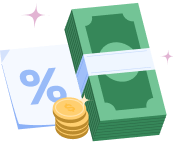Table of Contents
It’s tempting to just pay the “minimum due” on your credit card when cash is tight. The number looks small, manageable — and paying it feels responsible. But that decision carries a long-term cost most people don’t see coming.
Credit card companies design minimum payments to benefit them, not you. The goal? Keep you paying interest for as long as possible. That’s why millions of people find themselves trapped in what’s known as the “minimum payment trap” — where balances barely move, but interest quietly compounds.
In this blog, we’ll break down exactly why paying only the minimum is dangerous, how it leads to years of debt, and practical ways to escape the cycle — for good.
Understanding What the Minimum Payment Really Means
The “minimum due” on your credit card is typically 2–3% of your total balance. It might seem helpful — but it’s designed to keep your debt around for years.
Let’s say you have a $3,000 balance. Your minimum payment might be around $90. Of that, maybe $60 goes toward interest, and only $30 reduces your actual debt. That means after your payment, you still owe $2,970. Not much progress, right?
This system isn’t an accident — it’s how credit cards make money. Minimum payments are a financial leash: you’re technically “current” on your bill, but your debt barely shrinks. All the while, interest keeps adding up.
The Psychological Trap of the Minimum Payment
It Creates a False Sense of Progress
Paying something feels productive. But when most of your payment goes toward interest, you’re not really moving forward. Month after month, your balance stays nearly the same, even though you’re making payments.
“Affordability Illusion” Keeps People Hooked
Minimum payments make big debts seem manageable. A $10,000 balance? Just pay $250 this month! It sounds reasonable — but you’re barely chipping away at the principal. This illusion keeps people stuck in revolving credit, paying thousands in interest over time.
Emotional Relief, Financial Damage
The small relief of “at least I paid something” masks the long-term stress of growing debt. Behavioral finance shows we often choose short-term comfort over long-term benefit — and credit cards exploit that instinct.
How Minimum Payments Keep You in Debt Longer
Let’s break it down.
- Balance: $3,000
- APR: 20%
- Minimum payment: $90 (3%)
- Time to pay off (no new purchases): 17+ years
- Total paid: Over $6,000
You’ll pay twice your original balance, and spend nearly two decades doing it.
This is the credit card hamster wheel: you feel like you’re running, but you’re not going anywhere.
The Real Financial Risks of Paying Only the Minimum
1. Ballooning Interest Costs
When you only pay the minimum, your debt grows slowly — but your interest keeps adding up. That $500 TV could end up costing you $1,200 if carried on your card for a few years.
2. Declining Credit Score
High balances hurt your credit utilization ratio — a major factor in your credit score. If your credit limit is $5,000 and you carry a $4,000 balance, your utilization is 80% — a red flag for lenders.
Even if you pay on time, your score may still drop due to this high usage.
3. Reduced Borrowing Power
A poor credit score means higher interest rates on future loans — or even denial. That means you’ll pay more for car loans, mortgages, or personal loans — because of revolving credit card debt.
4. The Debt Snowball Effect
As your balance grows, your minimum payment increases. That leaves less room in your budget. Eventually, people use one card to pay off another, deepening the spiral.
5. Long-Term Financial Stress
Debt becomes a constant source of anxiety. You start avoiding statements, stop tracking your budget, or worse — spend more to numb the stress. It’s a vicious cycle that erodes your financial confidence.
Read: Debt Snowball vs. Debt Avalanche: Which Method Wins?
The Math Behind the Minimum Payment Trap
Let’s look at the numbers:
- Balance: $5,000
- APR: 22%
- Minimum payment: 3% (~$150)
- Time to pay off: ~19 years
- Total paid: ~$11,000
That’s more than double the original amount.
Here’s the painful truth: minimum payments aren’t helping you — they’re helping the bank.
Common Misconceptions About Minimum Payments
“I Won’t Be Charged Extra if I Pay the Minimum.”
Not true. You won’t be hit with late fees, but daily interest still accrues — often at 18–25% APR. That adds up fast.
“Paying the Minimum Builds Credit.”
Only partially true. On-time payments help, yes. But high balances hurt your score. To truly improve credit, you need low utilization (ideally under 30%) and consistent, on-time payments.
“I’ll Pay More Next Month.”
A common excuse — but the longer you wait, the more your minimum grows. And the harder it becomes to catch up.
The Hidden Cost — Your Future Money Goals
Every dollar you pay in interest is a dollar you can’t invest.
Let’s say you pay $200/month in credit card interest. Over 10 years, that’s $24,000 — gone. But if you had invested that in an index fund earning 8%, it could’ve grown to over $35,000.
Minimum payments steal your future wealth — silently.
How to Break Free From the Minimum Payment Trap
Step 1 — Always Pay More Than the Minimum
Even an extra $50/month can cut years off your debt.
Example: Pay $150 instead of $90, and you could pay off a $3,000 balance in 6 years instead of 17 — and save thousands in interest.
Step 2 — Use the Avalanche or Snowball Method
- Avalanche: Pay off high-interest cards first. This saves the most money.
- Snowball: Pay off smallest balances first. This gives you motivation and visible wins.
Choose the method that fits your mindset and stick with it.
Step 3 — Automate and Track Payments
Set up automatic payments for more than the minimum to stay consistent. Use budgeting apps or AI-powered wallets to track progress and avoid missed payments.
Step 4 — Consider a Balance Transfer or Consolidation
Look for 0% APR balance transfer cards or low-interest personal loans. These tools reduce your interest burden — but only if you don’t rack up new debt.
Step 5 — Reevaluate Spending Habits
Credit card debt often grows from emotional or impulse spending. Identify triggers, cut back on wants, and build spending awareness.
Awareness = control.
The Role of Financial Discipline and Awareness
Credit cards aren’t evil. In fact, when used responsibly, they offer great perks: cashback, rewards, travel points, and credit building.
The key? Pay the full balance every month.
Use credit cards as a tool, not an extension of your income. If you can’t afford to pay it off now, you can’t afford to charge it.
The Psychological Reward of Paying in Full
Becoming debt-free doesn’t just feel good — it transforms your mindset. Paying off balances brings relief, confidence, and momentum. It reduces stress, boosts self-control, and even improves your relationships.
The joy of financial freedom lasts longer than the fleeting excitement of shopping.
Conclusion — Break the Habit, Reclaim Your Future
Paying only the minimum might feel like a safe move — but it’s quietly stealing your freedom. You’re not avoiding debt — you’re prolonging it. It’s essential to consider not just the costs of living but also the tools that can give you more financial flexibility. Platforms like Beem offer features such as Everdraft™ for early deposit access and same-day cash options without credit checks or interest, making managing expenses less stressful.
Take charge today:
- Pay more than the minimum.
- Use strategic repayment methods.
- Track your progress.
- Say no to spending that doesn’t serve you.
The faster you pay your debt, the sooner your money starts working for you — not your credit card company. Download the beem app here.
FAQs on How Paying the Minimum on Credit Cards Is Risky
How much is the minimum payment on a credit card?
Usually 2–3% of your outstanding balance or a flat amount like $25–$50, whichever is higher. It’s just enough to keep your account in good standing — but not enough to reduce your debt meaningfully.
What happens if I always pay the minimum?
You’ll stay in debt for years, and the total interest paid can end up being two to three times your original purchase amount — making everything far more expensive over time.
Will paying only the minimum hurt my credit score?
Yes, especially if it leads to high credit utilization (using more than 30% of your credit limit), which is a major factor in lowering your credit score even if you pay on time.
How can I pay off credit card debt faster?
Pay more than the minimum each month, use a structured method like the avalanche (highest interest first) or snowball (smallest balance first), reduce new card spending, and explore balance transfers or consolidation to lower interest.
Is it better to close a paid-off credit card?
Not always. Keeping it open can help your credit by maintaining a longer credit history and lowering your overall credit utilization, both of which support a higher credit score.
















































